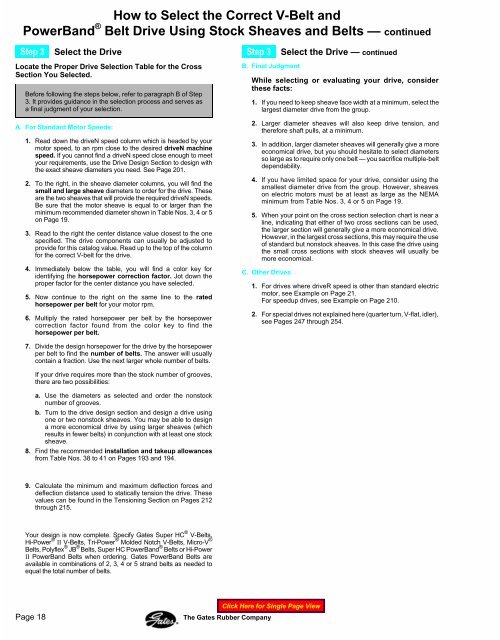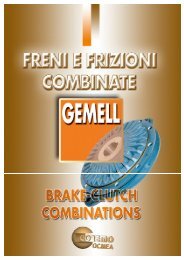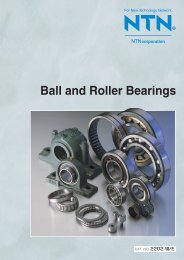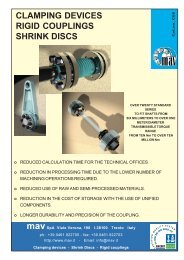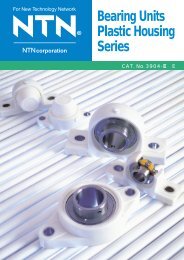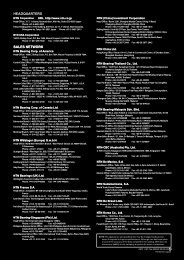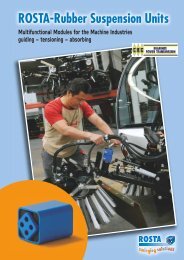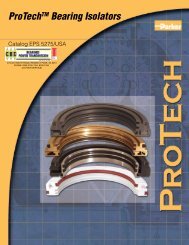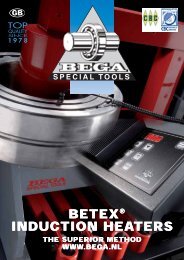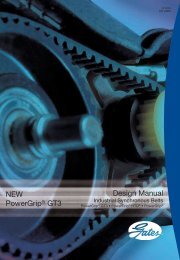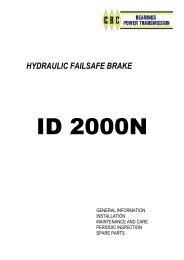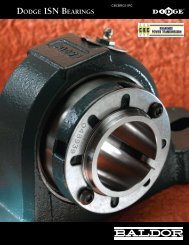Gates Heavy Duty V-Belt Drive Design Manual 14995-A
Gates Heavy Duty V-Belt Drive Design Manual 14995-A
Gates Heavy Duty V-Belt Drive Design Manual 14995-A
Create successful ePaper yourself
Turn your PDF publications into a flip-book with our unique Google optimized e-Paper software.
How to Select the Correct V-<strong>Belt</strong> and<br />
PowerBand ® <strong>Belt</strong> <strong>Drive</strong> Using Stock Sheaves and <strong>Belt</strong>s — continued<br />
Step 3 Select the <strong>Drive</strong><br />
Locate the Proper <strong>Drive</strong> Selection Table for the Cross<br />
Section You Selected.<br />
Before following the steps below, refer to paragraph B of Step<br />
3. It provides guidance in the selection process and serves as<br />
a final judgment of your selection.<br />
A. For Standard Motor Speeds:<br />
1. Read down the driveN speed column which is headed by your<br />
motor speed, to an rpm close to the desired driveN machine<br />
speed. If you cannot find a driveN speed close enough to meet<br />
your requirements, use the <strong>Drive</strong> <strong>Design</strong> Section to design with<br />
the exact sheave diameters you need. See Page 201.<br />
2. To the right, in the sheave diameter columns, you will find the<br />
small and large sheave diameters to order for the drive. These<br />
are the two sheaves that will provide the required driveN speeds.<br />
Be sure that the motor sheave is equal to or larger than the<br />
minimum recommended diameter shown in Table Nos. 3, 4 or 5<br />
on Page 19.<br />
3. Read to the right the center distance value closest to the one<br />
specified. The drive components can usually be adjusted to<br />
provide for this catalog value. Read up to the top of the column<br />
for the correct V-belt for the drive.<br />
4. Immediately below the table, you will find a color key for<br />
identifying the horsepower correction factor. Jot down the<br />
proper factor for the center distance you have selected.<br />
5. Now continue to the right on the same line to the rated<br />
horsepower per belt for your motor rpm.<br />
6. Multiply the rated horsepower per belt by the horsepower<br />
correction factor found from the color key to find the<br />
horsepower per belt.<br />
Step 3 Select the <strong>Drive</strong> — continued<br />
B. Final Judgment<br />
While selecting or evaluating your drive, consider<br />
these facts:<br />
1. If you need to keep sheave face width at a minimum, select the<br />
largest diameter drive from the group.<br />
2. Larger diameter sheaves will also keep drive tension, and<br />
therefore shaft pulls, at a minimum.<br />
3. In addition, larger diameter sheaves will generally give a more<br />
economical drive, but you should hesitate to select diameters<br />
so large as to require only one belt — you sacrifice multiple-belt<br />
dependability.<br />
4. If you have limited space for your drive, consider using the<br />
smallest diameter drive from the group. However, sheaves<br />
on electric motors must be at least as large as the NEMA<br />
minimum from Table Nos. 3, 4 or 5 on Page 19.<br />
5. When your point on the cross section selection chart is near a<br />
line, indicating that either of two cross sections can be used,<br />
the larger section will generally give a more economical drive.<br />
However, in the largest cross sections, this may require the use<br />
of standard but nonstock sheaves. In this case the drive using<br />
the small cross sections with stock sheaves will usually be<br />
more economical.<br />
C. Other <strong>Drive</strong>s<br />
1. For drives where driveR speed is other than standard electric<br />
motor, see Example on Page 21.<br />
For speedup drives, see Example on Page 210.<br />
2. For special drives not explained here (quarter turn, V-flat, idler),<br />
see Pages 247 through 254.<br />
7. Divide the design horsepower for the drive by the horsepower<br />
per belt to find the number of belts. The answer will usually<br />
contain a fraction. Use the next larger whole number of belts.<br />
If your drive requires more than the stock number of grooves,<br />
there are two possibilities:<br />
a. Use the diameters as selected and order the nonstock<br />
number of grooves.<br />
b. Turn to the drive design section and design a drive using<br />
one or two nonstock sheaves. You may be able to design<br />
a more economical drive by using larger sheaves (which<br />
results in fewer belts) in conjunction with at least one stock<br />
sheave.<br />
8. Find the recommended installation and takeup allowances<br />
from Table Nos. 38 to 41 on Pages 193 and 194.<br />
9. Calculate the minimum and maximum deflection forces and<br />
deflection distance used to statically tension the drive. These<br />
values can be found in the Tensioning Section on Pages 212<br />
through 215.<br />
Your design is now complete. Specify <strong>Gates</strong> Super HC ® V-<strong>Belt</strong>s,<br />
Hi-Power ® II V-<strong>Belt</strong>s, Tri-Power ® Molded Notch V-<strong>Belt</strong>s, Micro-V ®<br />
<strong>Belt</strong>s, Polyflex ® JB ® <strong>Belt</strong>s, Super HC PowerBand ® <strong>Belt</strong>s or Hi-Power<br />
II PowerBand <strong>Belt</strong>s when ordering. <strong>Gates</strong> PowerBand <strong>Belt</strong>s are<br />
available in combinations of 2, 3, 4 or 5 strand belts as needed to<br />
equal the total number of belts.<br />
Page 18<br />
The <strong>Gates</strong> Rubber Company


